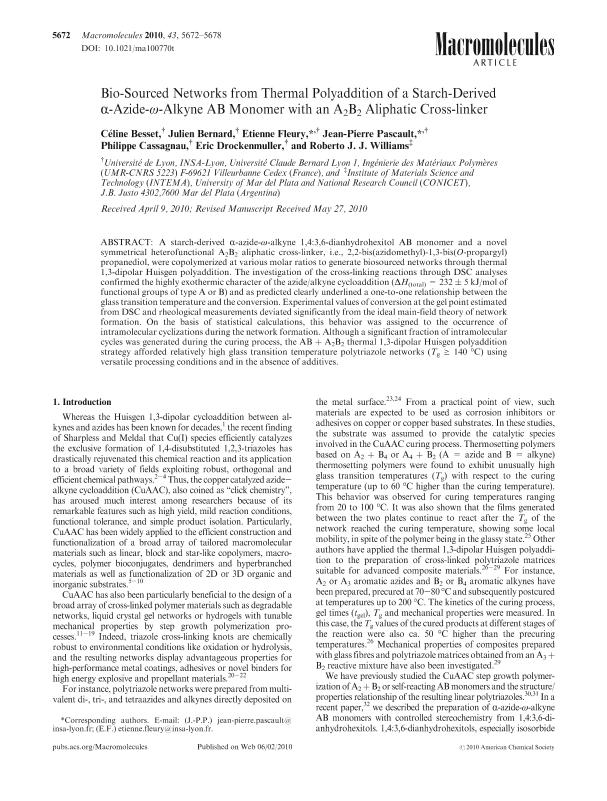Artículo
Bio-sourced networks from thermal polyaddition of a starch-derived α-Azide-ω-Alkyne AB monomer with an A2B2 aliphatic cross-linker
Besset, Cèline; Bernard, Julien; Fleury, Etienne; Pascault, Jean-Pierre.; Cassagnau, Philippe; Drockenmuller, Eric; Williams, Roberto Juan Jose

Fecha de publicación:
02/06/2010
Editorial:
American Chemical Society
Revista:
Macromolecules
ISSN:
0024-9297
Idioma:
Inglés
Tipo de recurso:
Artículo publicado
Clasificación temática:
Resumen
A starch-derived α-azide-ω-alkyne 1,4:3,6-dianhydrohexitol AB monomer and a novel symmetrical heterofunctional A2B2 aliphatic cross-linker, i.e., 2,2-bis(azidomethyl)-1,3-bis(O-propargyl) propanediol, were copolymerized at various molar ratios to generate biosourced networks through thermal 1,3-dipolar Huisgen polyaddition. The investigation of the cross-linking reactions through DSC analyses confirmed the highly exothermic character of the azide/alkyne cycloaddition (ΔH(total) = 232 ± 5 kJ/mol of functional groups of type A or B) and as predicted clearly underlined a one-to-one relationship between the glass transition temperature and the conversion. Experimental values of conversion at the gel point estimated from DSC and rheological measurements deviated significantly from the ideal main-field theory of network formation. On the basis of statistical calculations, this behavior was assigned to the occurrence of intramolecular cyclizations during the network formation. Although a significant fraction of intramolecular cycles was generated during the curing process, the AB + A2B2 thermal 1,3-dipolar Huisgen polyaddition strategy afforded relatively high glass transition temperature polytriazole networks (Tg ≥ 140 °C) using versatile processing conditions and in the absence of additives.
Archivos asociados
Licencia
Identificadores
Colecciones
Articulos(INTEMA)
Articulos de INST.DE INV.EN CIENCIA Y TECNOL.MATERIALES (I)
Articulos de INST.DE INV.EN CIENCIA Y TECNOL.MATERIALES (I)
Citación
Besset, Cèline; Bernard, Julien; Fleury, Etienne; Pascault, Jean-Pierre.; Cassagnau, Philippe; et al.; Bio-sourced networks from thermal polyaddition of a starch-derived α-Azide-ω-Alkyne AB monomer with an A2B2 aliphatic cross-linker; American Chemical Society; Macromolecules; 43; 13; 2-6-2010; 5672-5678
Compartir
Altmétricas



